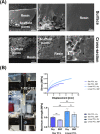High-Throughput Screening of Thiol-ene Click Chemistries for Bone Adhesive Polymers
- PMID: 37905511
- PMCID: PMC10636719
- DOI: 10.1021/acsami.3c12072
High-Throughput Screening of Thiol-ene Click Chemistries for Bone Adhesive Polymers
Abstract
Metal surgical pins and screws are employed in millions of orthopedic surgical procedures every year worldwide, but their usability is limited in the case of complex, comminuted fractures or in surgeries on smaller bones. Therefore, replacing such implants with a bone adhesive material has long been considered an attractive option. However, synthesizing a biocompatible bone adhesive with a high bond strength that is simple to apply presents many challenges. To rapidly identify candidate polymers for a biocompatible bone adhesive, we employed a high-throughput screening strategy to assess human mesenchymal stromal cell (hMSC) adhesion toward a library of polymers synthesized via thiol-ene click chemistry. We chose thiol-ene click chemistry because multifunctional monomers can be rapidly cured via ultraviolet (UV) light while minimizing residual monomer, and it provides a scalable manufacturing process for candidate polymers identified from a high-throughput screen. This screening methodology identified a copolymer (1-S2-FT01) composed of the monomers 1,3,5-triallyl-1,3,5-triazine-2,4,6(1H,3H,5H)-trione (TATATO) and pentaerythritol tetrakis (3-mercaptopropionate) (PETMP), which supported highest hMSC adhesion across a library of 90 polymers. The identified copolymer (1-S2-FT01) exhibited favorable compressive and tensile properties compared to existing commercial bone adhesives and adhered to bone with adhesion strengths similar to commercially available bone glues such as Histoacryl. Furthermore, this cytocompatible polymer supported osteogenic differentiation of hMSCs and could adhere 3D porous polymer scaffolds to the bone tissue, making this polymer an ideal candidate as an alternative bone adhesive with broad utility in orthopedic surgery.
Keywords: bone adhesive; click chemistry; cytocompatibility; high-throughput screening; orthopedics.
Conflict of interest statement
The authors declare no competing financial interest.
Figures




Similar articles
-
Management of urinary stones by experts in stone disease (ESD 2025).Arch Ital Urol Androl. 2025 Jun 30;97(2):14085. doi: 10.4081/aiua.2025.14085. Epub 2025 Jun 30. Arch Ital Urol Androl. 2025. PMID: 40583613 Review.
-
Comparison of Two Modern Survival Prediction Tools, SORG-MLA and METSSS, in Patients With Symptomatic Long-bone Metastases Who Underwent Local Treatment With Surgery Followed by Radiotherapy and With Radiotherapy Alone.Clin Orthop Relat Res. 2024 Dec 1;482(12):2193-2208. doi: 10.1097/CORR.0000000000003185. Epub 2024 Jul 23. Clin Orthop Relat Res. 2024. PMID: 39051924
-
The Black Book of Psychotropic Dosing and Monitoring.Psychopharmacol Bull. 2024 Jul 8;54(3):8-59. Psychopharmacol Bull. 2024. PMID: 38993656 Free PMC article. Review.
-
[Volume and health outcomes: evidence from systematic reviews and from evaluation of Italian hospital data].Epidemiol Prev. 2013 Mar-Jun;37(2-3 Suppl 2):1-100. Epidemiol Prev. 2013. PMID: 23851286 Italian.
-
Short-Term Memory Impairment.2024 Jun 8. In: StatPearls [Internet]. Treasure Island (FL): StatPearls Publishing; 2025 Jan–. 2024 Jun 8. In: StatPearls [Internet]. Treasure Island (FL): StatPearls Publishing; 2025 Jan–. PMID: 31424720 Free Books & Documents.
Cited by
-
Injectable, Solvent Free Strontium Carbonate Poly(Allyl Glycidyl Ether Succinate) Composite Networks for Vertebral Augmentation.Adv Healthc Mater. 2025 Jun 18:e2501633. doi: 10.1002/adhm.202501633. Online ahead of print. Adv Healthc Mater. 2025. PMID: 40531598
-
Biocompatible Multi-functional Polymeric Material for Mineralized Tissue Adhesion.bioRxiv [Preprint]. 2025 Jun 2:2025.05.30.656989. doi: 10.1101/2025.05.30.656989. bioRxiv. 2025. PMID: 40501574 Free PMC article. Preprint.
References
-
- Wu A. M.; Bisignano C.; James S. L.; Abady G. G.; Abedi A.; Abu-Gharbieh E.; Alhassan R. K.; Alipour V.; Arabloo J.; Asaad M.; Asmare W. N.; Awedew A. F.; Banach M.; Banerjee S. K.; Bijani A.; Birhanu T. T. M.; Bolla S. R.; Cámera L. A.; Chang J. C.; Cho D. Y.; Chung M. T.; Couto R. A. S.; Dai X.; Dandona L.; Dandona R.; Farzadfar F.; Filip I.; Fischer F.; Fomenkov A. A.; Gill T. K.; Gupta B.; Haagsma J. A.; Haj-Mirzaian A.; Hamidi S.; Hay S. I.; Ilic I. M.; Ilic M. D.; Ivers R. Q.; Jürisson M.; Kalhor R.; Kanchan T.; Kavetskyy T.; Khalilov R.; Khan E. A.; Khan M.; Kneib C. J.; Krishnamoorthy V.; Kumar G. A.; Kumar N.; Lalloo R.; Lasrado S.; Lim S. S.; Liu Z.; Manafi A.; Manafi N.; Menezes R. G.; Meretoja T. J.; Miazgowski B.; Miller T. R.; Mohammad Y.; Mohammadian-Hafshejani A.; Mokdad A. H.; Murray C. J. L.; Naderi M.; Naimzada M. D.; Nayak V. C.; Nguyen C. T.; Nikbakhsh R.; Olagunju A. T.; Otstavnov N.; Otstavnov S. S.; Padubidri J. R.; Pereira J.; Pham H. Q.; Pinheiro M.; Polinder S.; Pourchamani H.; Rabiee N.; Radfar A.; Rahman M. H. U.; Rawaf D. L.; Rawaf S.; Saeb M. R.; Samy A. M.; Sanchez Riera L.; Schwebel D. C.; Shahabi S.; Shaikh M. A.; Soheili A.; Tabarés-Seisdedos R.; Tovani-Palone M. R.; Tran B. X.; Travillian R. S.; Valdez P. R.; Vasankari T. J.; Velazquez D. Z.; Venketasubramanian N.; Vu G. T.; Zhang Z. J.; Vos T. Global, Regional, and National Burden of Bone Fractures in 204 Countries and Territories, 1990–2019: A Systematic Analysis from the Global Burden of Disease Study 2019. Lancet Healthy Longevity 2021, 2 (9), e580–e592. 10.1016/S2666-7568(21)00172-0. - DOI - PMC - PubMed
-
- Baydar M.; Aydın A.; Şencan A.; Orman O.; Aykut S.; Öztürk K. Comparison of Clinical and Radiological Results of Fixation Methods with Retrograde Intramedullary Kirschner Wire and Plate-Screw in Extra-Articular Metacarpal Fractures. Jt. Dis. Relat. Surg. 2021, 32 (2), 397.10.52312/jdrs.2021.40. - DOI - PMC - PubMed
-
- Farrar D. F. Bone Adhesives for Trauma Surgery: A Review of Challenges and Developments. Int. J. Adhes. Adhes. 2012, 33, 89–97. 10.1016/j.ijadhadh.2011.11.009. - DOI
Grants and funding
LinkOut - more resources
Full Text Sources

